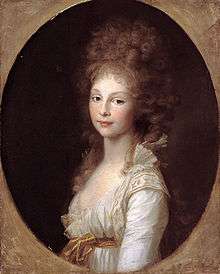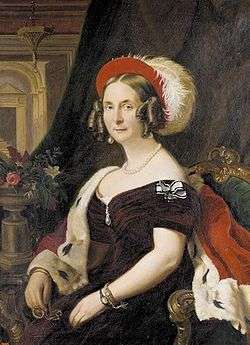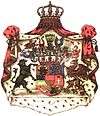Frederica of Mecklenburg-Strelitz
| Frederica | |||||
|---|---|---|---|---|---|
|
Princess Louis Charles of Prussia Princess Frederick William of Solms-Braunfels Duchess of Cumberland and Teviotdale | |||||
 Portrait by Johann Tischbein, 1796. | |||||
| Queen consort of Hanover | |||||
| Tenure | 20 June 1837 – 29 June 1841 | ||||
| Predecessor | Adelaide of Saxe-Meiningen | ||||
| Successor | Marie of Saxe-Altenburg | ||||
| Born |
3 March 1778 Hanover | ||||
| Died |
29 June 1841 (aged 63) Hanover | ||||
| Burial | Herrenhausen Palace, Hanover | ||||
| Spouse |
Prince Louis Charles of Prussia (m. 1793; dec. 1796) Prince Frederick William of Solms-Braunfels (m. 1798; dec. 1814) Ernest Augustus I of Hanover (m. 1815) | ||||
| Issue (more...) |
Prince Frederick of Prussia Frederica Wilhelmina, Duchess of Anhalt-Dessau Prince William of Solms-Braunfels Augusta, Princess Albert of Schwarzburg-Rudolstadt Prince Alexander of Solms-Braunfels Prince Carl of Solms-Braunfels George V of Hanover | ||||
| |||||
| House |
House of Mecklenburg-Strelitz (by birth) House of Hanover (by marriage) House of Hohenzollern (by marriage) House of Solms-Braunfels (by marriage) | ||||
| Father | Charles II, Grand Duke of Mecklenburg-Strelitz | ||||
| Mother | Landgravine Friederike of Hesse-Darmstadt | ||||
Frederica of Mecklenburg-Strelitz (full name: Friederike Louise Caroline Sophie Charlotte Alexandrine) (3 March 1778 – 29 June 1841), was a German princess who became, by marriage, a princess of Prussia, a princess of Solms-Braunfels, Duchess of Cumberland in Britain and, finally, Queen of Hanover in Germany) as the consort of Ernest Augustus I of Hanover, the fifth son and eighth child of King George III.
She was born in the Altes Palais of Hanover as the fifth daughter of Charles II, Duke of Mecklenburg-Strelitz, and his first wife, Frederica, daughter of Prince George William of Hesse-Darmstadt.[1]
Her father assumed the title of Grand Duke of Mecklenburg on 18 June 1815. Duchess Frederica was the niece of her future mother-in-law, Queen Charlotte (formerly Duchess Charlotte of Mecklenburg-Strelitz), since her last husband was her first cousin.
Early life
Frederica's mother died on 22 May 1782 after giving birth to her tenth child. Two years later (28 September 1784), her father remarried the younger sister of his deceased wife, Landgravine Charlotte of Hesse-Darmstadt, but this union ended just one year later, when Charlotte died of complications resulting from childbirth on 12 December 1785. The twice-widowed Duke Charles considered himself unable to give his daughters proper rearing and education, so he sent Frederica and her elder sisters Charlotte, Therese and Louise to their maternal grandmother, Princess Maria Louise of Hesse-Darmstadt. Princess Maria Louise's choice of a Swiss teacher for the girls, Salomé de Gélieu, proved to be a good one. Some time later, Duke Charles also sent his two surviving sons, the Hereditary Grand Duke George and Charles, to be raised by their grandmother.
First marriage
Frederica's parents were anxious to arrange advantageous marriages for all their daughters, and used family connections to bring this about. Queen Frederika Louisa of Hesse-Darmstadt, wife of King Frederick William II, was a first cousin of Frederica's mother. Frederica's parents broached with the Prussian royal family the idea of marriage between their children, and the Prussians were not averse. On 14 March 1793, the Princesses of Mecklenburg-Strelitz "coincidentally" met the Prussian King Frederick William II at the Prussian Theatre in Frankfurt-am-Main. He was immediately captivated by the grace and charm of both sisters, Frederica and Louise. The pending marriage negotiations received traction, and within weeks, the matter was settled: Frederica's elder sister Louise would marry Crown Prince Frederick William, and Frederica would marry his younger brother Prince Louis.[1]

The double engagement was celebrated in Darmstadt on 24 April 1793, only a few weeks after the sister fortuitously met their future father-in-law at the theatre. On December 24, Louise and Crown Prince Frederick William were married in the Royal Palace of Berlin; two days later, on 26 December, Frederica and Prince Louis were also married at the same venue.[1]
Unlike her sister, Frederica did not enjoy a happy marriage. Although her husband died only three years after the wedding, that period is said to have been rather unhappy. Louis is said to have preferred the company of his mistresses and completely neglected his wife, or at least, that is her version; in response, she allegedly began an affair with her husband's uncle Prince Louis Ferdinand. Despite her husband's alleged neglect, Fredrica did bear him three children in as many years: Frederick in 1794; a short-lived son, Charles, in 1795; and a daughter, Frederica, in 1796.
In 1795, King Frederick William II appointed Louis as Chief of the Dragoons Regiment No.1, which was stationed in Schwedt. One year later, on 23 December 1796, Prince Louis died of diphtheria. It was three years almost to the day since their wedding. At this time, his youngest child, Frederica, was less than three months old, and his eldest son was hardly two years old. After Louis's death, his father provided Frederica with a suitable residence near Berlin, and a sufficient income, and she moved with her three children to Schönhausen Palace near Berlin.
In 1797, Frederica and her cousin Prince Adolphus, Duke of Cambridge, seventh son of King George III of Great Britain by his wife Queen Charlotte (Frederica's paternal aunt), became unofficially engaged. The Duke of Cambridge asked the consent of his father to the marriage, but the King, under pressure from his wife, refused.
Second marriage
In 1798 Frederica became pregnant. The father was Prince Frederick William of Solms-Braunfels. The prince recognized his paternity and requested her hand in marriage, a proposal that was quickly granted in order to avoid scandal. On 10 December of that year, the couple was married in Berlin and immediately moved to Ansbach.[1] Two months later, in February 1799, Frederica gave birth to a daughter who only lived eight months. Prince Frederick William, disappointed and embittered, resumed his old dissipated lifestyle and became an alcoholic. In 1805 he resigned his military posts for "health reasons". Frederica had to maintain her family with her own resources after her brother-in-law, King Frederick William III of Prussia, refused to restore her annual pension as a dowager princess of Prussia. Frederica's older brother-in-law and head of the family, William Christian, Prince of Solms-Braunfels, advised her to get a divorce, with his full approval. She and her husband nonetheless refused.
Third marriage
In May 1813, during a visit to his uncle Duke Charles in Neustrelitz, Prince Ernest Augustus, Duke of Cumberland, the fifth son of King George III of Great Britain, met and fell in love with Frederica. Duke Charles made it clear to his daughter that her separation from the Prince of Solms-Braunfels was absolutely logical, and that he saw a marriage with an English prince as a great opportunity for her. During the next months Frederica considered the intentions of Ernest Augustus and the possible effects on her own situation. When, after the victory of the allies in the Battle of Leipzig, Ernest Augustus spent some days in Neustrelitz, he was greeted enthusiastically. Some time later Frederica asked the Prussian king for approval for her divorce from Prince Frederick William of Solms-Braunfels. All parties agreed, including the Prince of Solms-Braunfels, but Frederick William's sudden death on 13 April 1814 precluded the need for a divorce. The prince's demise was considered by some as a little too convenient, and some suspected that Frederica had poisoned him.[3] In August, the engagement with Ernest Augustus was officially announced. After the British Prince Regent gave his consent to the wedding, Frederica and Ernest Augustus were married on 29 May 1815 at the parish church of Neustrelitz.[1] Some time later, the couple traveled to Great Britain and married again on 29 August 1815 at Carlton House, London.[1]
Queen Charlotte bitterly opposed the marriage, even though her future daughter-in-law was also her niece. She refused to attend the wedding and advised her son to live outside England with his wife. Frederica never obtained the favor of her aunt/mother-in-law, who died unreconciled with her in 1818. During her marriage to Ernest Augustus she gave birth thrice, but only a son survived, who would eventually become King George V of Hanover.[1]
Queen of Hanover

On 20 June 1837 King William IV of the United Kingdom and Hanover died without issue. His heir was Princess Victoria, only daughter of Prince Edward Augustus, Duke of Kent, but because Hanover had been ruled under semi-Salic Law since the times of the Holy Roman Empire, she could not inherit the Hanoverian throne. The next male descendant of the late king was the Duke of Cumberland, Frederica's husband, who then became King Ernest Augustus I of Hanover, with Frederica as his Queen consort.[1]
After a short illness, Queen Frederica of Hanover died in 1841 at Hanover.[1] The Court master builder Georg Ludwig Friedrich Laves was instructed by the King to build a mausoleum for his wife and himself in the garden of the chapel at Herrenhausen Palace. He also gave royal orders for the transformation of a central square near the Leineschloss and renamed it Friederikenplatz in her honor.
Titles, styles, honours and arms
- 3 March 1778 – 26 December 1793: Her Serene Highness Duchess Frederica of Mecklenburg-Strelitz[1]
- 26 December 1793 – 10 December 1798: Her Royal Highness Princess Louis Charles of Prussia
- 10 December 1798 – 29 August 1815: Her Serene Highness Princess Frederick William of Solms-Braunfels
- 29 August 1815 – 29 June 1841: Her Royal Highness The Duchess of Cumberland and Teviotdale
- 20 June 1837 – 29 June 1841: Her Majesty The Queen of Hanover
Issue
| Name | Birth | Death | Notes |
|---|---|---|---|
| By Prince Frederick Louis of Prussia (married 29 December 1793; he died 23 December 1796) | |||
| Prince Frederick Wilhelm Ludwig of Prussia | 30 October 1794 | 27 July 1863 | married, 1817, Princess Louise of Anhalt-Bernburg |
| Prince Frederick Wilhelm Charles George of Prussia | 26 September 1795 | 6 April 1798 | |
| Princess Frederica Wilhelmina Luise Amalie of Prussia | 30 September 1796 | 1 January 1850 | married, 1818, Leopold IV, Duke of Anhalt |
| By Prince Frederick William of Solms-Braunfels (married 10 December 1798; he died 13 April 1814) | |||
| Princess Sophia of Solms-Braunfels | 27 February 1799 | 20 October 1799 | |
| Prince Frederick William of Solms-Braunfels | 11 September 1800 | 14 September 1800 | |
| Prince Frederick Wilhelm Heinrich Casimir Georg Karl Maximilian of Solms-Braunfels | 13 December 1801 | 12 September 1868 | married, 1831, Countess Maria Kinsky von Wchinitz und Tettau |
| Princess Augusta Luise Therese Matilda of Solms-Braunfels | 25 July 1804 | 8 October 1865 | married, 1827, Albert, Prince of Schwarzburg-Rudolstadt |
| Unnamed daughter | 1805 | 1805 | stillborn |
| Prince Alexander Frederick of Solms-Braunfels | 12 March 1807 | 20 February 1867 | married, 1863, Baroness Louise of Landsberg-Velen |
| Prince Frederick Wilhelm Ludwig Georg Karl Alfred Alexander of Solms-Braunfels | 27 July 1812 | 13 November 1875 | married, 1845, Princess Sophie of Löwenstein-Wertheim-Rosenberg |
| By Prince Ernest Augustus, Duke of Cumberland and Teviotdale (later King Ernest Augustus I of Hanover) (married 29 May 1815) | |||
| Princess Frederica of Cumberland | 27 January 1817 | 27 January 1817 | stillborn |
| Unnamed daughter | April 1818 | April 1818 | stillborn |
| George V of Hanover | 27 May 1819 | 12 June 1878 | married, 1843, Marie of Saxe-Altenburg; had issue |
Ancestry
References
- 1 2 3 4 5 6 7 8 9 10 Willis, Daniel A., The Descendants of King George I of Great Britain, Clearfield Company, 2002, p. 73. ISBN 0-8063-5172-1
- ↑ Clark, Christopher (2006). Iron Kingdom: The Rise and Downfall of Prussia, 1600–1947, p. 316. Cambridge, Massachusetts, USA: Belknam Press of Harvard University Press.
- ↑ Van der Kiste, p. 114
External links
| Wikimedia Commons has media related to Friederike von Mecklenburg-Strelitz. |
- "Friederike Luise Karoline Sophie Charlotte Alexandrine Herzogin von Mecklenburg-Strelitz" at The Peerage
| Frederica of Mecklenburg-Strelitz Born: 3 March 1778 Died: 29 June 1841 | ||
| Hanoverian royalty | ||
|---|---|---|
| Preceded by Adelaide of Saxe-Meiningen |
Queen consort of Hanover 20 June 1837 – 29 June 1841 |
Succeeded by Marie of Saxe-Altenburg |
